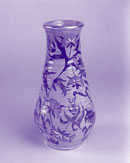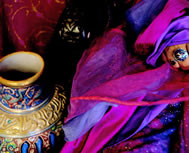




 |
    |
Reviews |
||
 |
Lietuvos Rytas - StiliusThe Home of The Artist - Carolinda Tolstoy By Kristina Sabaliauskaite The South London home of ceramicist Carolinda Tolstoy is already a part of contemporary interior design history. The publishers of ‘Dream Homes’ and ‘Arabesque’, volumes and editors of interior design magazines describe her style as contemporary Orientalism, whereas her friends call the house simply “The Pink Palace”. Indeed, in the space worth of ‘One Thousand and One Night’ tales of small miracles abound, but probably the most important miracle of all is the artist’s will and imagination, that converted this typical London building into a pink oasis within the grey city. Carolinda Tolstoy kindly opens the door to her home. It could be said, that the Orient runs in her veins: the London-born artist is of Greek and Middle Eastern origins and for twenty seven years was married to Count Andrei Tolstoy - Miloslavsky, a descendant of the famous writer and the important figure in the London’s Russian community, the organizer of the “War and Peace Ball”. It was Count Tolstoy who helped to discover the talent for ceramics. “At the time I had the idea of selling ceramics, but during our vacation in Spain in the Seventies when we visited the pottery workshops he kept asking me: “Why couldn’t you try as well?”. Thus I enrolled in pottery classes, became an apprentice, taught and later started doing my own thing” – recalls Countess Tolstoy. Today Carolinda Tolstoy is a widely acclaimed ceramicist, who gives master classes for Central St. Martin’s and Royal College of Art, with a history of exhibitions at important museums and galleries internationally and her work now comprises also ‘brush embroidery’ on textiles and interiors. “I can decorate almost anything, the things for the home I can’t make I simply bring from the East” – she smiles. A woman of magnificent and exotic type of beauty she seems to have descended from the pages of a Persian poem: copious jewellery, pink and purple ornate fabrics of her clothing, a massive belt – everything suits her totally. “I dress this way every day, even when going to a supermarket. But, in fact, these days I shop for groceries on the Internet” – she says. To my question whether sometimes, as they say, one of her “previous lives” was in another time or part of the world, she replies: “But of course! I feel very close to the fifteenth-sixteenth century Renaissance, and I do not have in mind only European Renaissance, but also the Persian Renaissances and their ornate, ornamental styles that migrated and influenced Europe. Everything, in fact, was so mixed at that time – just look at the oriental luxury of the Elizabethan costumes. This aesthetic is very close to me. I could not survive in a minimalist, white surrounding.” So a standard London residential house, where the Tolstoy family has been living for twenty-eight years in two years became transformed into an unusual world (the artist’s imagination spared only the top two floors of the house, where preserving their youthful autonomy live her twenty and twenty one year-old sons and visiting daughter and her husband).“No rules, no regrets and no concerns about what people will say“ that is the advice of Carolinda Tolstoy for those who aim to create their dream home. “Who said, that the walls have to be white and light if you want the effect of spaciousness?” – she asks ironically, because she has achieved the effect of space using the pink wall paint of different swirling shades. “Who said, that the kitchen has to be tiled? Why can’t it look like a nightclub?” – she laughs, because she has painted all her kitchen furniture black with a splendid golden leaf pattern (and I mean all – not only the wall cupboards, that contain her lustre glazed crockery, but also the fridge freezer). “Who said, that a fireplace must be either with coal or with logs?” – she argues, because the flames of her gas fireplace spring out of a heap of clay pomegranates pots and amphoras. Huge decorated pots with golden cupolas are the chimneys on the roof. “Who said, that the shelves have to be straight?” – she asks rhetorically, because she has created the original but functional flowing, sinuous shelves that are perfectly suitable for her collection of different height pieces of ceramic work. A series of orientally-shaped niches in the walls also serve the same purpose. The artist has also designed more things – the lamps, the intricatelly patterned window bars, the custom made carpet, the dining table for 10 people... but I heard that the legendary soirées of Carolinda Tolstoy are not limited to that number of people, as quite recently she has entertained at her house no less than...250 guests. Why pink? Why pink on the walls and ceilings and even the ink is pink in her “Parker” fountain pen when she writes her best regards to “Stilius” readers? Does it have some special symbolic meaning for her? “Pink and its spectrum are creativity and vitlity in the mind and spirit.” She shows a smallish painting that she made when a five year old girl for her grandmother. There, I see the same flowing, sinuous shapes, pink and purple tones with a turquoise brushstrokes. “Nothing has changed, just the realisation that came with the years. I have been working in and realising the same colours and shapes.” She refers to the sinuous, plant inspired brushstokes lines characteristic to her oeuvre as “the sinuous Line of Life – the undulating misshapen shapes, as life is misshapen... the line that is constrained to the round of the vessel and now abounding, bursting, flying, leaping into life, flowing in disregard over corners, cornices, pipes, doors, walls and ceilings... the invisible Line of Life that brings together a myriad of ideas, peoples, countries, backgrounds, subjects, cultures...” and adds that sometimes, when she wears her richely decorated gowns she feels like a vessel herself. I must agree with that, and add – a vessel which contains a genie of unrestrained creativity and of which one gust is enough for the surrounding world to be transformed according to Carolinda Tolstoy.
|
 |
| © Carolinda Tolstoy 1999-2018 | Web site design: QuincDigital |